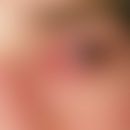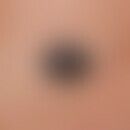Synonym(s)
DefinitionThis section has been translated automatically.
Rare complication after iatrogenic damage of the trigeminal nerve (70%). Triggered e.g. by interventions at the ganglion Gasseri or neurological diseases (10%) such as among others ischemic nuclear lesions with characteristic defect in the area of distribution of the n.trigeminus (often nasal defect/ulcération en arc) as well as anesthesia and paresthesia in the affected innervation area of the 2nd trigeminal branch. See also malum perforans.
EtiopathogenesisThis section has been translated automatically.
The syndrome is usually caused by iatrogenic damage to the trigeminal nerve, usually in connection with the treatment of trigeminal neuralgia by destruction of the Gasserian ganglion, nerve exheresis or traumatic nerve lesion. More rarely, Wallenberg's syndrome (circulatory disturbances of the anterior cerebellar artery) or processes damaging the sensory spinae nucleus of the trigeminal nerve are present. In rare cases, zoster disease can also lead to such a complication (Kautz O et al. 2009) .
Basically, the dissociation of pain and touch sensation leads to the fact that the patient perceives the itch, but his scratching does not "cover" the itch, but rather intensifies it. The consequence is that the patient intensifies the scratching.
You might also be interested in
ManifestationThis section has been translated automatically.
The average age of the disease is 50-55 years.
LocalizationThis section has been translated automatically.
Nostril (80%); r. and/0r li. cheek. (28%); upper lip (10%); cornea 18%. Tip of nose always remains free.
ClinicThis section has been translated automatically.
Eminently chronic, crust-covered, 0.5-1.0 cm ulcer with a punched-out appearance and crater-like margins. There is no healing tendency despite adequate therapeutic measures. No evidence of local infection. Slight collateral redness is possible. The periulcerous skin is hypoesthetic or anesthetic. Subjective discomfort is mild because of the presence of analgesia.
Differential diagnosisThis section has been translated automatically.
Ulcerated basal cell carcinoma (Ulcus rodens)
cutaneous leishmaniasis
artifact
herpes simplex infection
TherapyThis section has been translated automatically.
Manipulations of the nostril triggered by dysesthesia and crust formation cause or support ulcer development. Informing the patient about the connection is therefore the first measure. If manipulations are avoided (if necessary also by protective dressings), complete healing can occur. Since the disease often occurs in older, psychologically aged people, manipulation cannot be eliminated in all cases.
Therapeutic attempts with electrostimulation, vitamin B preparations, and antidepressants have been described (carbamazepine, gabapentin).
In case of extensive findings, surgical reconstruction or epithetic treatment. Risk of recurrence is > 50%.
In case of superinfection, local antiseptic externals such as Betaisodona ointment. Prior histological exclusion of malignant changes is important.
LiteratureThis section has been translated automatically.
- Litschel R et al (2003) Herpes zoster-associated trigeminal trophic syndrome: a case report and review. Eur Arch Otorhinolaryngol 260: 86-90.
- Kautz O et al (2009) Trigeminal trophic syndrome with extensive ulceration following herpes zoster. Eur J Dermatol 19:61-63.
- Khan AU et al (2019) Trigeminal trophic syndrome: an updated review. Int J Dermatol 58: 530-537.
- Maaßen D et al (1990) The neurotrophic trigeminal syndrome. Akt Dermatol 16: 3-6
- McVeigh KA et al (2018) Periocular manifestations of trigeminal trophic syndrome: A case series and literature review. Orbit 37:32-35.
- Mohammadi A et al (2020) Trigeminal trophic syndrome as an Unusual Cause of Chronic and Non-Healing Ala Nasi Ulcer: A Case Report. World J Plast Surg 9:346-348.
- Sawada T et al (2014) Trigeminal trophic syndrome: report of a case and review of the published work. J Dermatol 41:525-528.
- Weintraub E et al (1982) Trigeminal trophic syndrome. J Am Acad Dermatol 6: 52-57.
Incoming links (5)
Malum perforans; Trigeminal syndrome, neurotrophic; Trigeminal trophic syndrome ; Trophoneurotic ulcer; Ulcer, neurotrophic in neurotrophic trigeminal syndrome;Outgoing links (1)
Malum perforans;Disclaimer
Please ask your physician for a reliable diagnosis. This website is only meant as a reference.





